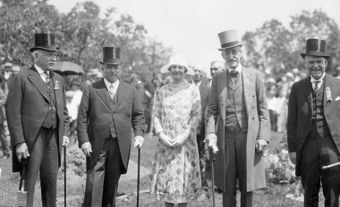
Earl Grey: The Governor General of Canada (1904–1911)
mikephilipsforcongress.com – Earl Grey, born Charles Grey, served as the Governor General of Canada from 1904 to 1911, during a pivotal period in the nation’s history. His time in office coincided with Canada’s emergence as a growing and increasingly independent nation within the British Empire. Earl Grey’s tenure was marked by his strong personal involvement in the development of Canadian society, his role in promoting the arts, and his active participation in the nation’s social and cultural affairs. Under his leadership, Canada continued to assert its autonomy, and the office of Governor General became more closely aligned with the evolving Canadian identity.
Early Life and Background
Charles Grey was born on March 11, 1851, in London, England, into a distinguished family with deep ties to British aristocracy. He was the son of the 4th Earl Grey and Lady Mary Louisa, daughter of the 1st Earl of Listowel. He was educated at Eton and later at Oxford University, where he developed an interest in politics, diplomacy, and the arts.
Before becoming Governor General of Canada, Earl Grey held various positions within British public service, including serving as a Member of Parliament and as a prominent figure in British politics. He was also deeply involved in charitable work and public affairs, which would later inform his work in Canada. Earl Grey’s aristocratic background, experience in governance, and commitment to social causes made him well-suited to serve as the representative of the British Crown in Canada.
Appointment as Governor General
In 1904, Earl Grey was appointed Governor General of Canada by King Edward VII, succeeding Lord Minto. At the time, Canada was continuing to assert its autonomy as a self-governing Dominion within the British Empire. While the country had gained significant political independence, it still maintained strong ties to Britain, and the office of Governor General was viewed as an important symbol of those connections.
Earl Grey’s appointment came at a time when Canada was increasingly asserting its identity on the world stage. The early 20th century saw the nation growing both economically and politically, and Earl Grey’s leadership was crucial in navigating the changing dynamics between Canada and Britain, as well as between Canada’s various cultural communities.
A Champion of Canadian Identity
One of Earl Grey’s most notable contributions during his time as Governor General was his support for the development of Canadian national identity. His administration encouraged pride in Canadian culture and fostered the growth of national institutions that reflected the country’s distinctiveness. Earl Grey was particularly passionate about Canadian art, culture, and sports, and his involvement helped shape the cultural landscape of the nation during his tenure.
A key initiative of Earl Grey’s tenure was his sponsorship of the Canadian Rugby Football Union and the establishment of the Earl Grey Cup, a prestigious trophy that became a symbol of Canadian athletic achievement. His active involvement in promoting Canadian sports helped bolster a sense of national unity and pride, particularly as the country became more self-assured in its cultural identity.
The Canadian Military and National Defence
Another significant aspect of Earl Grey’s tenure was his advocacy for the development of Canada’s military and national defence. During the early 20th century, Canada’s role within the British Empire was evolving, and the country’s growing sense of autonomy was beginning to shape its military policy.
In 1909, Earl Grey’s administration was instrumental in the creation of the Canadian Militia Act, which provided the framework for the establishment of Canada’s first formal army. Under his leadership, the Canadian military was reorganized and modernized to meet the needs of a nation that was increasingly asserting its autonomy on the world stage. Earl Grey’s efforts helped lay the foundation for Canada’s military contributions in future international conflicts, including World War I.
Indigenous Affairs and Social Policy
While Earl Grey’s tenure is often remembered for his contributions to Canadian culture and identity, his administration also faced ongoing challenges regarding the treatment of Indigenous peoples in Canada. Throughout the early 20th century, Indigenous communities continued to face systemic discrimination, forced assimilation policies, and a loss of their lands and cultures.
Earl Grey showed personal sympathy for Indigenous peoples and took steps to address their concerns, but his time in office did not lead to significant policy changes that would improve the living conditions or rights of Indigenous communities. However, Earl Grey was involved in the establishment of several educational initiatives and charitable organizations aimed at improving the conditions of Indigenous peoples, although these efforts were often framed within a colonial perspective.
As Governor General, Earl Grey’s involvement with Indigenous affairs was largely symbolic, and the significant policy changes that would benefit Indigenous communities would not occur until decades later.
Canada’s Growing Autonomy
The period of Earl Grey’s governorship coincided with the gradual increase in Canada’s political autonomy. Canada had already established itself as a self-governing Dominion within the British Empire, and during Earl Grey’s tenure, the country’s political maturity became more evident.
Earl Grey’s leadership reflected the changing relationship between Canada and Britain. While still a part of the British Empire, Canada was increasingly managing its own affairs and asserting its sovereignty. Earl Grey’s role as Governor General involved navigating this complex relationship, particularly as Canada began to establish its own voice in international diplomacy.
In 1909, Earl Grey’s administration played a significant role in the negotiation of the Anglo-Japanese Alliance, which had an impact on Canada’s foreign policy. While Canada was still a British Dominion, the growing sense of national autonomy meant that the country began to take a more active role in global affairs.
The Canadian Confederation and Expansion
Earl Grey’s time as Governor General also coincided with continued expansion and development across Canada. The western provinces were undergoing rapid settlement, and the construction of new infrastructure, particularly in the areas of transportation and communication, was vital to the economic development of the country. Under Earl Grey’s leadership, Canada continued to grow both geographically and economically, and his administration was supportive of policies that helped foster this growth.
Canada’s population continued to diversify as immigrants from Europe and other parts of the world settled in Canada. Earl Grey was sympathetic to the challenges of integrating these new populations into Canadian society and worked to promote immigration and settlement policies that would strengthen the nation’s demographic and cultural fabric.
Conclusion
Earl Grey’s time as Governor General of Canada from 1904 to 1911 was a period of significant change and growth for the young nation. His contributions to the development of Canadian culture, identity, and military infrastructure helped lay the foundation for Canada’s future as a self-assured and independent nation. Earl Grey’s personal engagement in promoting Canadian arts, sports, and national pride left a lasting legacy, while his efforts to support Canada’s growing military and national defence were critical to the country’s evolving role in international affairs.
While challenges regarding Indigenous rights and social policy persisted during his tenure, Earl Grey’s leadership helped set the stage for Canada’s future trajectory as a prominent member of the British Commonwealth and an increasingly autonomous nation in its own right. His legacy continues to be recognized as an important chapter in Canada’s history.


